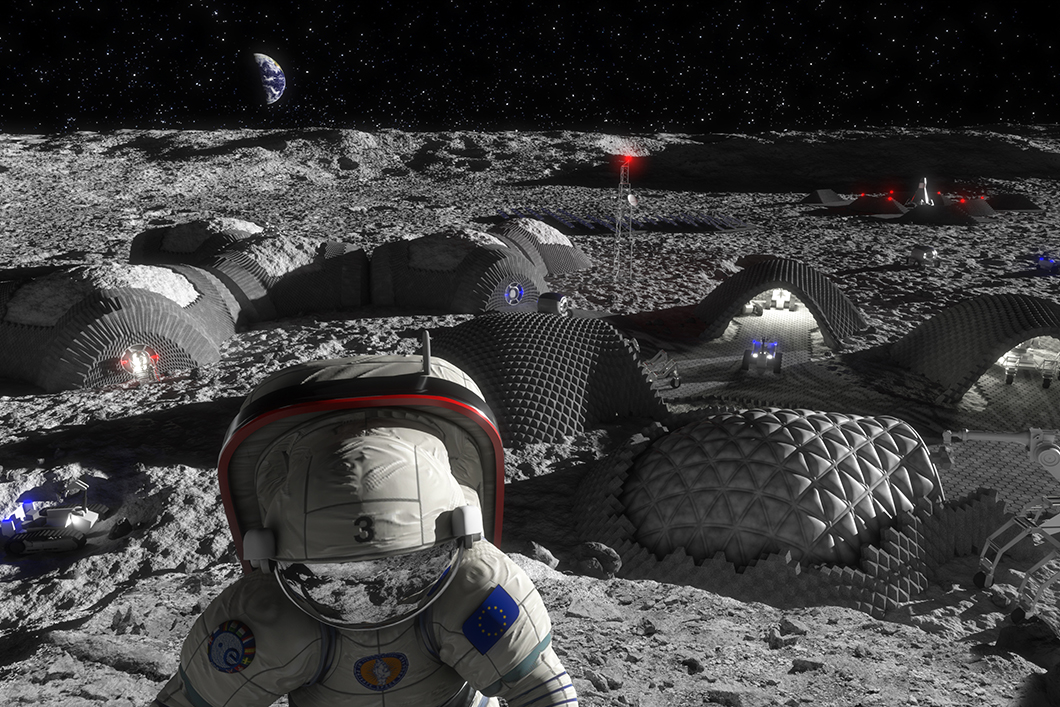
Source: RegoLight Consortium 2018, visualization: LIQUIFER Systems Group
Project period
01/06/2021 - 30/11/2022
Project type
EU project
Project status
Closed
Description
How will we explore, work, and live on the moon? Project PAVER – Paving the road for large area sintering of regolith aims at demonstrating the sintering and melting of lunar regolith simulant material to produce large scale 3D printed elements that could be used during human and robotic lunar explorations.
Location
Bundesanstalt für Materialforschung und -prüfung
Unter den Eichen 87
12205 Berlin
Source: ESA, DLR, TU Clausthal, Aalen University, Liquifer, BAM
A prerequisite for lunar exploration and beyond is the manufacturing of objects directly on the moon, given the extreme costs involved in the shipping of material from Earth. Looking at processes, raw materials, and energy sources, equipment will certainly have to be brought from Earth at the beginning. Available on the moon are lunar regolith as raw material and the sun as an energy source. One of the first steps towards the establishment of a lunar base is the creation of infrastructure elements, such as roads and landing pads.
Source: BAM
The goal ist to demonstrate the sintering and melting of the lunar regolith simulant ‘EAC-1A’ from the European Astronaut Centre (EAC) to produce large scale printed elements that could be used during human and robotic lunar explorations.
Source: BAM
The project focuses on the design of test geometries as well as a manufacturing strategy for these geometries using a layer-by-layer sintering approach. While the vision is to use lunar soil and the sun as the only energy source on the moon, on Earth the team is using a representative laser for the sintering of the material.
Source: BAM
Coordination
BAM Advanced Multi-materials Processing division
Partners
LIQUIFER Systems Group (project page)
Aalen University (project page)
TU Clausthal
Associated partner: DLR Institute of Materials Physics in Space
ESA project; part of Open Space Innovation Platform – Off-Earth Manufacturing Campaign
Project ‘PAVER – Paving the road for large area sintering of regolith’ aims at demonstrating the sintering and melting of the lunar regolith simulant (‘EAC-1A’ from the European Astronaut Centre (EAC)) to produce large scale printed elements that could be used during human and robotic lunar explorations. The project focuses on the design of test geometries as well as a manufacturing strategy for these geometries using a layer-by-layer sintering approach. While the vision is to use lunar soil and the sun as the only energy source on the moon, on Earth the team is using a representative laser for the sintering of the material.
Since the start of the project in June 2021, the team has already achieved some significant outcomes. The material has been characterized and sintering strategies have been evaluated to produce samples with different thickness dependent on the sintering time and energy. The mineralogy of the simulant fits with the composition of lunar anorthositic rocks and a comparison of the used simulant with a sample from Apollo 14 and other simulants was conducted. Images of the particles show that the particles have a regular shape with sharp edges. After sintering with a single laser spot, the sample exhibits a dense but glassy phase. A detailed analysis is ongoing. After initial testing, the samples did not survive the rapid cooling down after switching off the laser and they crack: typically, two large cracked split the sample into four major parts.

Scanning electron microscope image of the EAC-1A lunar regolith simulant (left) and a piece of the sintered and cracked material (right)
Source: Aalen University, BAM/TU Clausthal
Later, single sintered tracks were generated with a crucible moving under the laser spot. In these tests the sample only cracked towards the end of the track. This situation is comparable to the single spot sintering with a rapid cooling down. However, the slow cooling associated with the moving laser spot is apparently sufficient to reduce thermal stress to a level, at which no cracking is induced anymore.

Single track sintering (left) and generated sample (right), cracking only towards the end of the track
Source: BAM/TU Clausthal
The team is planning to continue the work on the sintering of single and then multiple tracks. The ultimate goal is to pave a road on the surface of the moon. Later, process-optimized geometries will be developed to create interlocking 2.5D paving elements. Further detailed mechanical and microstructural analysis will be conducted to reveal more information about the properties of the sintered material.
Project coordination
Bundesanstalt für Materialforschung und -prüfung (BAM)
Partners
LIQUIFER Systems Group (project page)
Aalen University (project page)
TU Clausthal
Associated partner: DLR Institute of Materials Physics in Space
ESA project as part of the Open Space Innovation Platform (OSIP) – Off-Earth Manufacturing Campaign


